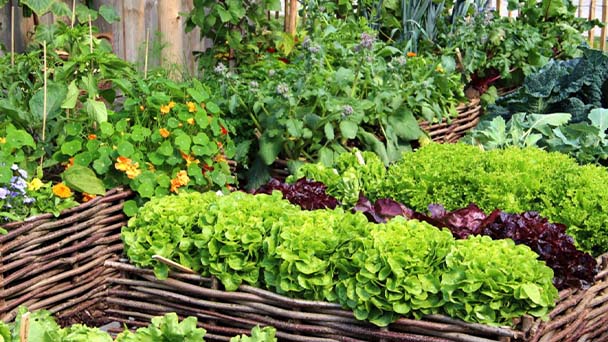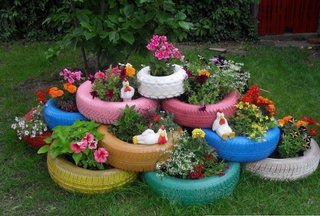How to make garden at home
Written by Joy
Sep 29 2020

How to make garden at home? Different gardens will have different construction orders. For example, the order of new gardens and renovation gardens, balcony gardens and courtyard gardens will be different. This time we take the most perfect new garden at home as an example to how to make garden at home.

There are two points to pay special attention to here about how to make garden at home. First, the cement must be selected. The higher the label, the stronger the cement strength. You should choose the appropriate label according to the load-bearing needs. Secondly, you ought to choose the right brick. Currently, the commonly used mainly include hollow bricks and red bricks. , Refractory bricks, ceramic tiles, etc., the first three are mostly used for building walls, but the texture is different, and the last is mostly used for paving the ground.
What you need to pay attention to is that, although the projection lamp directly irradiated on the plant will not have a big impact on the growth of the plant, it may inhibit or promote the flowering of the plant. At the same time, outdoor lamps and lanterns are subject to wind and rain all year round. You should choose wind-proof and waterproof lamps, and wire joints should be handled properly to avoid leakage.
Preparation before construction
Mainly to confirm the environmental conditions of the garden. Including the soil thickness, orientation and sunshine of the garden, monsoon wind direction, temperature and humidity, changes in the surrounding environment, the presence or absence of wires and drainage systems, etc., and contrast with the construction drawings at the time of design. These actually need to be confirmed at the beginning of the design, but often some unprofessional companies ignore this step and cause major changes to the drawings after construction, delaying the construction period and wasting the owner's budget. Therefore, to make a perfect garden, you also need to find a comprehensive service company with excellent design and construction while making garden at home.Land preparation
Since the original garden is often overgrown with weeds or irrelevant objects, in order to facilitate subsequent construction, the site must be cleared and the site preparation must be carried out. When preparing the site, the height of the soil layer is adjusted according to the needs of the construction drawings or according to the needs. You need to dig down. At the same time, the soil can be analyzed. If the soil conditions are not good, you need to introduce soil suitable for planting plants from the outside, or add suitable organic fertilizer, and plow 20~30cm deep, so that the base fertilizer can be fully mixed into the soil.Drainage works
Drainage works are a major focus in making garden at home. After all, no one wants a beautiful garden to become a swamp. Therefore, the drainage test must be performed first. First you should find out the slope of the original drain slope and the location of the drain hole. If there is a drain hole, you can first pull a root pipe to fill the water to see if it flows away quickly. If the flow is too slow, or even stagnant water, drain the pipe. Then directly water the base to test the drainage of the spillway slope to check whether there is stagnant water or water flow. If the drainage is really unsatisfactory, a bottom drainage pipe needs to be installed in the soil layer. At the same time, you'd better remember to protect the drainage hole so that it will not be blocked by subsequent construction if making garden at home.
Mud works
Mud work is usually used for wall, walkway, base and other projects. When carrying out a mud construction project, the base must be grounded first, and there will be processes such as excavation, tying steel bars, and filling cement. The subsequent construction sequence is usually from top to bottom, first on the wall and then on the walkway.There are two points to pay special attention to here about how to make garden at home. First, the cement must be selected. The higher the label, the stronger the cement strength. You should choose the appropriate label according to the load-bearing needs. Secondly, you ought to choose the right brick. Currently, the commonly used mainly include hollow bricks and red bricks. , Refractory bricks, ceramic tiles, etc., the first three are mostly used for building walls, but the texture is different, and the last is mostly used for paving the ground.
Pavement works
Paving refers to the hard ground of making garden at home. Commonly used materials are logs, synthetic wood, pebbles, slate, stones, tiles, etc. These materials are usually mixed and matched to create a rich sense of hierarchy. Rough burnt tiles can be used for the walkway, so that it is not easy to slip. For places that are easy to get dirty, it is best to use ceramic tiles instead of stone for easy cleaning. If you want to walk into the garden barefoot, you can use wood. During construction, you'd better pay attention to whether the pavement is firm, and try to see if there is a sense of shaking or depression when stepping on it. At the same time, paying attention to the flatness, watering to see if there will be water is necessary when making garden at home.Planting Project
When the main hardware project is completed, you can start planting the protagonist of the garden-plants! The order of planting mainly depends on the size of the plants to make garden at home, and they are planted in descending order, generally: trees→shrubs→herbs→ground cover and turf. The planting engineering is actually quite professional, especially when it comes to the issue of plant configuration. You will introduce such matching knowledge in the future. The key is to choose a professional service company. Good companies usually have professional plant configuration designers.Sprinkler irrigation project
Generally speaking, when the plant grows stably and the roots are deeply inserted into the soil, there is no need for an automatic watering system for your garden at home. However, if you are in a high temperature and low rain environment, or if you often go out and you are not at home and cannot water, it is necessary to install an automatic sprinkler irrigation system. First of all, the water must be filtered to ensure that the water is pure, so as not to block the nozzle and affect the operation of the pump, and secondly you’d better ensure sufficient water pressure. In addition, it is necessary to install a rain sensor to avoid raining and continue watering, and pay attention to the uniformity of the actual watering. If there is a dead angle, you need to adjust the nozzle position or water manually.Lighting project
The lighting projects in the garden also need to be carefully arranged. There are floor lamps to illuminate the ground, low lamps with guiding functions, projection lamps to highlight the main tree, recessed lamps embedded in the building, and wall lamps to create atmosphere. In addition to providing lighting. Besides, it also brings another kind of beauty to the your garden at home at night.What you need to pay attention to is that, although the projection lamp directly irradiated on the plant will not have a big impact on the growth of the plant, it may inhibit or promote the flowering of the plant. At the same time, outdoor lamps and lanterns are subject to wind and rain all year round. You should choose wind-proof and waterproof lamps, and wire joints should be handled properly to avoid leakage.
Latest Updated
- Benefits of Bugleweed - 7 Science-backed Health Benefits
- Bugleweed Dangers & Side Effects - Is It Poisonous?
- How to Plant Evergreen Trees - What You Should Know
- When to Plant Evergreens - Grow Guide for Evergreen Trees
- 12 Wonderful Evergreen Shrubs for Your Garden
- 12 Popular Evergreen Plants with Pictures for Beginners
- When And How To Prune A Lilac Bush Like a Pro
- How to Grow & Care for Lilac Vine (Hardenbergia Violacea)
- Japanese Lilac Tree (Syringa Reticulata) Care & Propagation Guide
- Shumard Oak Pros and Cons - What to Know
Popular Articles
- Winter maintenance of Antirrhinum Majus
- How to Grow Terminalia Mantaly Tree
- How to Grow and Care for Crossostephium Chinense
- How to grow Antirrhinum Majus in spring
- Peristeria Elata (Dove Orchid) Profile: Info & Care Guide
- Underwatered Snake Plant (Sansevieria Trifasciata) - Signs And How To Fix
- How to Care for Brazilian Jasmine Plant (Mandevilla Sanderi)
- How to Grow & Care for Graptopetalum Purple Delight in Summer
- Rosa Chinensis (China Rose): Plant Growing & Care Tips
- How to Care for Baby Sun Rose (Aptenia Cordifolia)